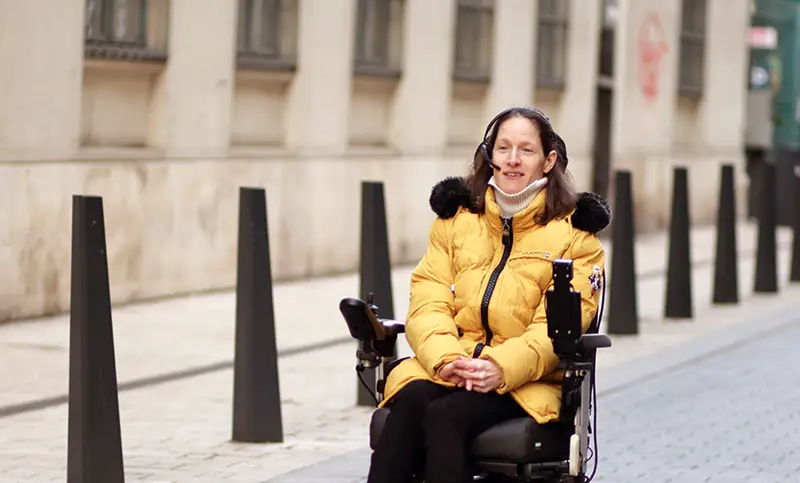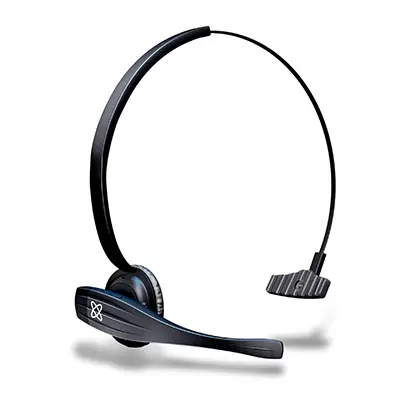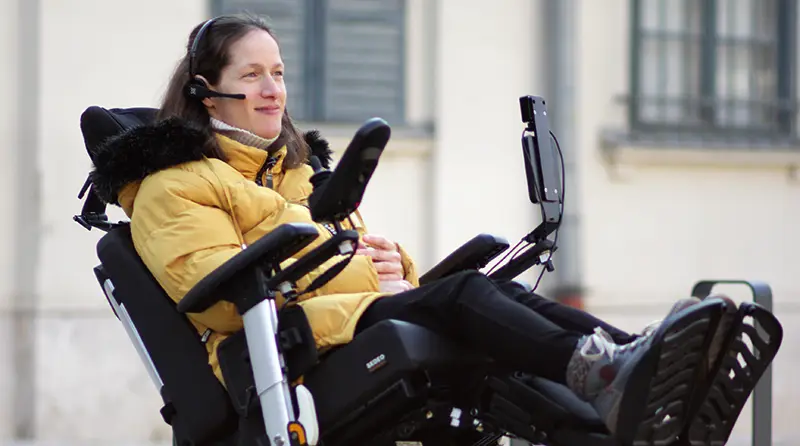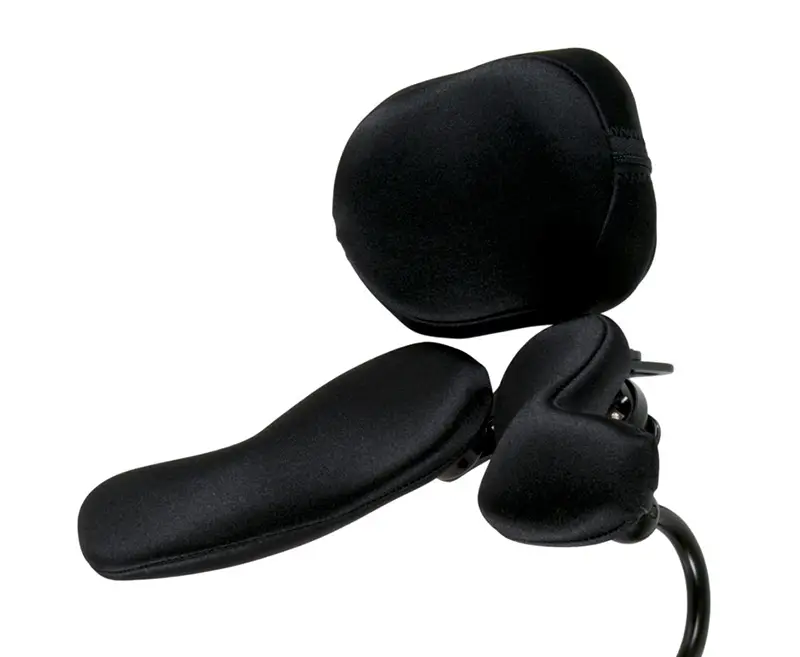Head controls for power wheelchairs
Head- and neck-based power wheelchair control systems have existed almost as long as power wheelchairs themselves. Rooted in environmental controls of the 1960s,1 pneumatic or 'sip and puff' technology allows operation of assistive technology using only a series of defined breath inputs into a straw.2 The breath inputs act as four switches to operate the chair.3 Still in use, this system requires good breath control, patience to learn the non-proportional chair movements (yes/no in a specific direction rather than gently graded control through 360 degrees) and some find the presence of a straw intrusive. Soon after, various versions of chin controls allowed a fully proportional joystick to be mounted at chin level for more intuitive control that responded in speed and direction precisely to joystick movements.4 Yet, this can still be difficult. Chin controls can slip out of place, be uncomfortable or fatiguing, or irritate the skin.
Later, head arrays such as the Switch-It Switched Head Array allowed wheelchair operation with no equipment in front of the driver's face. They had the additional benefit of positive impacts on head control in some cases, but the proportionality of a chin control was lost. More recently, headrest-based head control that use independently programmable force and proximity sensors like the Switch-It Dual Pro provide fully proportional, nuanced control.

As innovative as this most recent generation of head arrays has been, they also have limitations. Although consistent positioning is generally easier with a head array than a chin control, they can still be pulled out of place on hoists or with rough handling. Clients who shift their head position significantly during the day can slip out of alignment needed to control their wheelchairs. Lateral headrest pads can provide a period of rest, but also appear bulky.
Bluetooth wireless headset option: The Switch-It Vigo
A new type of fully wireless headset-style wheelchair control enables completely wireless wheelchair operation. Using Bluetooth technology, the Switch-It Vigo allows operation of the wheelchair and seating functions.
How does it work?
The Vigo uses a gyroscope and Bluetooth to provide a wireless, proportional head controller incorporated into a headset. Small gyroscope sensors measure head movements in three dimensions. The headset then transfers this information via Bluetooth to a small receiver that attaches to the Omni 2 wheelchair control display screen. This display screen is commonly used with all special input devices on Sunrise Medical wheelchairs. This information on head movements enables full proportional driving. It also can control a mobile phone with Bluetooth, like the other controls, but has the addition of a small microphone in the headset for clear voice reception. The Vigo has proprietary software for custom programming via a USB dongle plugged into a computer. This same dongle allows the wearer to operate a computer mouse, even without any further programming of the general wheelchair control system like other special input devices require.
How is it pronounced?
It is pronounced using a long E sound: Vēgo. Although our UK author noted that Britain likes to go a bit rogue at times, so Vigo rhyming with "I go" happens, too.

Who would use a Vigo head control?
Much like other head control options, someone who has fair-to-good head control without pain, but is not able to use an extremity to control a joystick could find they have independent wheelchair operation with the Vigo. It offers the additional benefit of being able to recalibrate during the day, so even in the individual shifts position, the wheelchair still functions well. It works on small, gentle movements, so it's best suited for people with good coordination. Although it can work on very subtle movements, the driver needs to have consistent movement without pain in cervical flexion/extension and lateral cervical flexion in each direction. It is a lightweight unit separate from the chair, eliminating concerns of being pulled about by family, assistants, or others. Once the head control is separated from the chair, its light weight means it needs to be put in a safe place to prevent damage. There needs to be a routine to ensure it will be store safely. It also needs to have its batteries charged nightly (via standard mini USB). Some examples of diagnoses of people who have been successful with the Vigo include:
- Spinal cord injuries (SCI)
- Cerebral Palsy (CP)
- Multiple Sclerosis (MS)
- Traumatic brain injury (TBI) or stroke
- Peripheral nerve injuries
- Amyotrophic Lateral Sclerosis (ALS) / Motor Neurone Disease (MND)

What other clinical considerations are there?

Since the Vigo does not include a head support, it is important to ensure that the wheelchair has a good fitting head support. This provides the option to rest when the chair is not use and for orientation when driving the chair. Since the Vigo uses right and left lateral flexion to turn the chair, consider a headrest with lateral cervical support (side neck pads) for comfortable use over long periods, such as the Whitmyer S.O.F.T. range.
So, if your client needs a head control and wants a low-profile wireless option with easy computer connectivity, the new Vigo is worth considering.
References
- The South West Film and Television Archive. (1975). Sip-and-Puff Assistive Technology [Film]. British Film Institute. Retrieved 21 June 2023 from: https://player.bfi.org.uk/free/film/watch-sip-and-puff-assistive-technology-1975-online
- Rodrigo, S. E., & Herrera, C. V. (2008). Wheelchairs: history, characteristics, and technical specifications. In Smart Wheelchairs and Brain-Computer Interfaces (pp. 257-290). Academic Press.
- Arshak, K., Buckley, D., & Kaneswaran, K. (2006). Review of assistive devices for electric powered wheelchairs navigation. The ITB Journal, 7(1), 3.
- Lipskin, R. (1970). An evaluation program for powered wheelchair control systems. Bull. Prosth. Res, 6, 121-219.
Faith Brown is an HCPC-registered occupational therapist with over 20 years of international experience in the field of seating and mobility including the British National Health Service, as well as the private and NGO sectors. She has worked with all ages and levels of complexity, including leading an NHS special seating division. She is a research champion for the Royal College of Occupational Therapists and has a history of lifelong professional development. Her post-qualification education includes a postgraduate certificate in Postural Management for People with Complex Disabilities from Oxford Brookes University, an MSc in Health Research Methods from the University of Birmingham (UK) and completion of an engineering module in wheelchair design at the University of San Francisco.
With over 40 years of clinical practice as an OT, Jessica Pedersen has worked in all sectors of the wheelchair and seating industry as a master clinician, supplier, manufacturing consultant, design representative, and educator. Dr. Pedersen was a pioneer in the development of the profession of wheelchairs and seating in the 1980s and has spent the last two decades contributing to the research world to demonstrate evidence for knowledge translation in the clinic, advocacy, and product development. She is a RESNA and AOTA Fellow, serves on the Clinician Task Force, the Seating and Wheeled Mobility Committee for AOTA, and has shared her experiences internationally through publications and presentations.